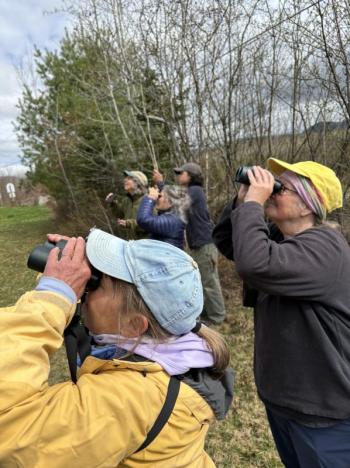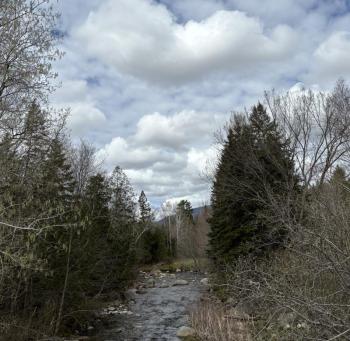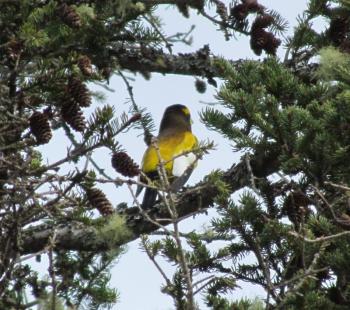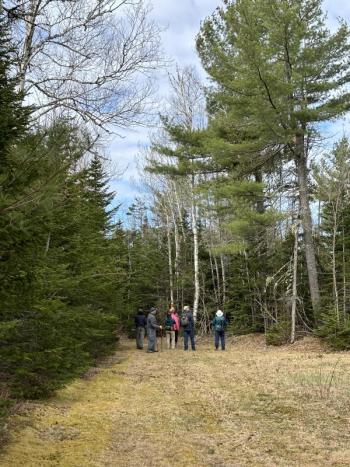A New Place For Birding Awaits You
Looking for a new place to go birding? We’ve got just the place for you. It’s called the Perham Stream Birding Trail, and it’s located in Madrid, Maine.
For those who may be a little rusty on their Maine geography, Madrid is located about a 40-minute drive north of Farmington. For the skiers out there, as the crow flies the Perham Stream Birding Trail is only about 5 miles from Saddleback Mountain and 10 miles from Sugarloaf Mountain. The Appalachian Trail passes by just about four and half miles north as well.
This adventure will give you stunning views of the mountain landscape visible from multiple places along the wide and (mostly) easy trails on this new 80-acre preserve of the High Peaks Alliance, a group dedicated to conservation and providing public access to open spaces in that beautiful part of the state.
We visited this weekend (second weekend in May) as bird guides for the Natural Resources Council of Maine’s (NRCM) field trip and had the pleasure of meeting a few folks associated with the High Peaks Alliance while spending a few hours enjoying the birds in this little-known gem of a preserve and learning a little about the NRCM members on the trip.
On arrival, you’ll be struck by the feeling of being in a place that has a distinctly northern feel to it even though it’s only an hour and fifteen minutes north of Augusta. Thanks to modern technology, it’s pretty easy to find on the mostly dirt East Madrid Road, although be aware that, at least when we visited, there was no sign indicating the name of the road where it meets Route 142 about 2.5 miles north of the intersection with well-known Route 4.
There is ample parking at the trailhead, and birders will be delighted to spend time perusing the birds at the many feeders at the nearby home of the original landowner—historian, and bird lover, Carson. When we arrived, twittering tree and barn swallows swirled around in the air above us while a gorgeous male rose-breasted grosbeak wowed us from the nearest bird feeder in a lilac beside Carson’s driveway. A couple of white-crowned sparrows with their jaunty head stripes showed off nicely on the ground under the feeder.
As we began the walk up the slight hill, we heard a Nashville warbler singing from the hillside, loudly singing its “see-bit, see-bit, see-bit tee-tee-tee-tee-tee”. Later, we heard many more, most staying just out of sight, until, near the end of the trail, we finally had one show off its yellow undersides, gray helmet and white eye ring to our entire group of 16 bird enthusiasts.
We were delighted to hear the long, melodious song of a winter wren come wafting out of a wet tangle of spruce and fir woods. Golden-crowned kinglets, red-breasted nuthatches, and lots of white-throated sparrows serenading us with their familiar “Old-sam-peabody, peabody, Peabody,” songs were there, too.
A small pocket of migrating warblers popped up near the site of the old post office and schoolhouse, allowing us to combine two of our passions—history and birding! Black-and-white warbler, northern parula, yellow-rumped warbler, and a sharp-looking male black-throated blue warbler bopped around along the forest edge.
But our favorite bird of the day came just as we got back near the trailhead. An evening grosbeak, a bird we don’t get to see that often anymore due to major populations declines, gave its distinctive call and there it was, almost glowing yellow from the middle of a spruce. A little later we saw several more feeding at Carson’s feeders.
We all left feeling content. If you visit Perham Stream Birding Trail, we’re sure you will, too!
Jeffrey V. Wells, Ph.D., is a Fellow of the Cornell Lab of Ornithology and Vice President of Boreal Conservation for National Audubon. Dr. Wells is one of the nation's leading bird experts and conservation biologists. He is a coauthor of the seminal “Birds of Maine” book and author of the “Birder’s Conservation Handbook.” His grandfather, the late John Chase, was a columnist for the Boothbay Register for many years. Allison Childs Wells, formerly of the Cornell Lab of Ornithology, is a senior director at the Natural Resources Council of Maine, a nonprofit membership organization working statewide to protect the nature of Maine. Both are widely published natural history writers and are the authors of the popular books, “Maine’s Favorite Birds” (Tilbury House) and “Birds of Aruba, Bonaire, and Curaçao: A Site and Field Guide,” (Cornell University Press).
































.png)

.png)
